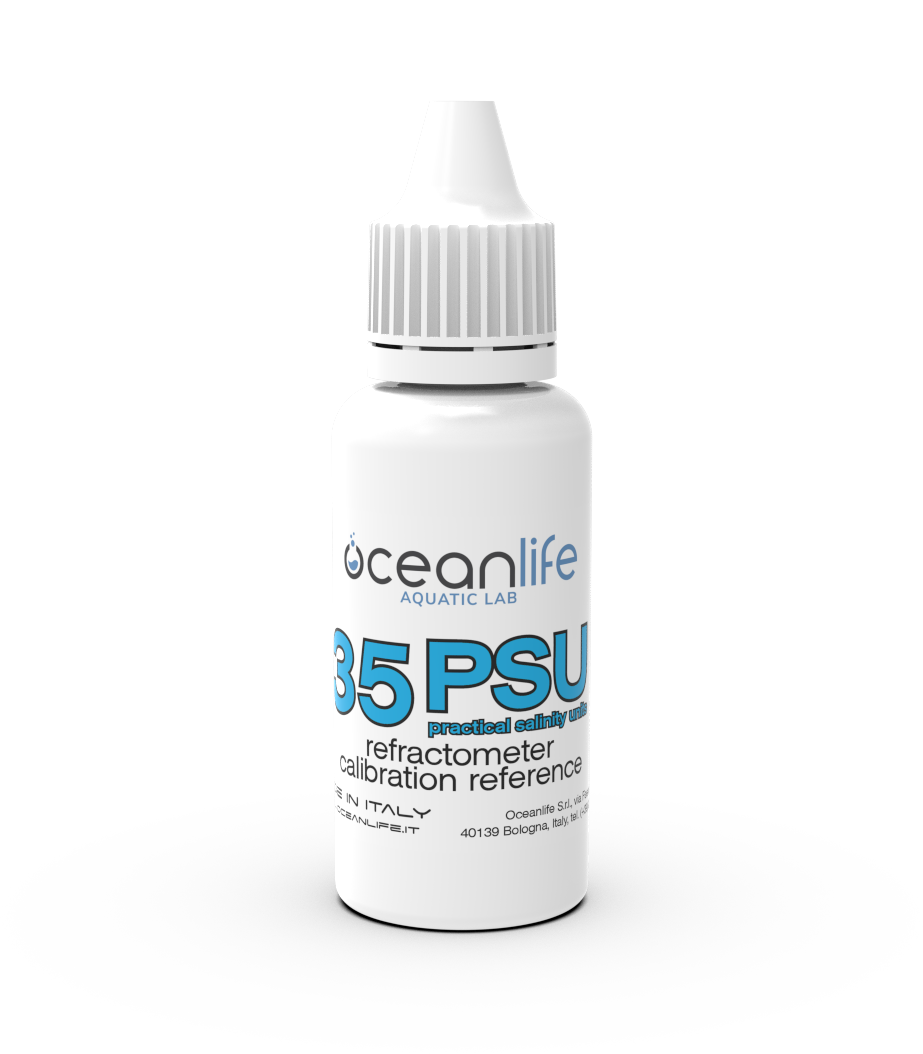Software
Here you can find the most complete salinity conversion software on the internet
salinity convertermethods of measuring salinity
The correct measurement of salinity is of fundamental importance for having stable values of calcium, magnesium, carbonates and in general of all the elelations present in sea water.
The study of the evaluation of the exact density of sea water has been going on for several decades and is a complex polynomial function of salinity, temparature and pressure.
We understand what the main water parameters are and how they interact with one another.
Salinity
To simplify, salinity (S) is the concentration of salts measured in PSU (Practical Salinity Units). It is expressed in g/kg and is invariant with temperature. It is the most important parameter.
Tropical seawater has a salinity of 35 PSU.
One of the most common mistakes is to confuse the salinity which is measured in PSU (therefore in g/kg) with the density which is measured in g/liter.
Although the mistake is minimal, salting water based on liters of water and not based on kg of water is not a scientifically correct practice. This is due to the fact that, like all other materials, water changes volume based on temperature and 1 liter of water weighs differently depending on temperature.
Other units of measurement of salinity are ppt (parts per thousand) or ‰ (per thousand).
Density
Density (D) is a function of salinity (in PSU), temperature and pressure. It is measured in Kg/m3 or g/liter.
With a salinity of 35 PSU and a temperature of 25°C, sea water has a surface density of 1023.34 g/liter.
With a salinity of 35 PSU and a temperature of 20°C, sea water has a surface density of 1024.76 g/liter.
Pure water, at 25°C and atmospheric pressure, has a density of 997.048 g/liter.
Specific Gravity
Specific gravity (SG) is defined as the ratio between sea water density and pure water density. It is a dimensionless measure, so it is not followed by any unit of measurement. It varies with temperature changes.
With a salinity of 35 PSU and a temperature of 25°C, sea water has a specific gravity at the surface of 1.0264.
With a salinity of 35 PSU and a temperature of 20°C, sea water has a specific gravity at the surface of 1.0266.
Conductivity
By simplifying, the conductivity of a fluid is its ability to carry electric charges. The salinity can be calculated starting from the conductivity through a complex polynomial equation that has like other variables the temperature and the pressure.
With a salinity of 35 PSU and a temperature of 25°C, sea water has a conductivity of 53.07 mS/cm.
With a salinity of 35 PSU and a temperature of 20°C, sea water has a conductivity of 47.91 mS/cm.
Interpretation errors
- Having a water at 35 PSU means that the water has a salt content of 35g per kg of water, not every liter.
- One liter of sea water at 25°C weighs 1.02334 kg, thus containing 35.82 g of salts. As the density depends on the temperature, to have a salinity of 35 PSU, the quantity of salts per liter of water must also be slightly different depending on the water temperature.
- The only unit invariant with the temperature is the salinity expressed in PSU (g/kg), since the weight does not change with the temperature.
Measurement tools
Densimeter or Hydrometer
Until recently, the most used method to measure the density (thus the salinity) was the hydrometer. Through a float rod, thanks to the Archimedes principle that regulates the float of bodies, the higher the density, the more the hydrometer rod is pushed out of the water. A graduated scale indicates the density of the water.
This method has the drawback that the measurement depends on the temperature, therefore calculations are required to convert the result obtained from the calibration temperature of the densimeter to the temperature of the water we measured.
Refractometer
It is currently the most used method. Thanks to the principle of refraction, a ray of light is refracted through the salt water at an angle that is dependent on salinity and temperature. The temperature of the instrument and that of the water are the parameters that most influence the measurement.
Most refractometers on the market should have automatic temperature compensation, which means that, once calibrated at the temperature indicated in the instructions, the salinity measurements are returned to that temperature generally between 10 and 30 °C.
For example, if the instrument is at 20 °C and the calibration solution at 20 °C, the reading will be reported as if the water measured were at 20 °C for any sample with temperature between 10 and 30 °C.
Conductivity meter
It is the most widely used method in industry or for process automation or in aquarium computers. Conductivity meters usually have a temperature compensation but it is not optimized for sea water measurement unless explicitly specified. In this regard it is necessary to correct the reading to obtain the correct salinity value.
measurement errors
Behind the apparent simplicity of use of the refractometer, there are insidious errors that lead to completely incorrect readings of salinity, resulting in a more than significant change in the parameters of the water.
- Many refractometers on the market do not have temperature compensation or compensation does not work. To find out if your refractometer is (yet) compensated, take some water from the aquarium and measure it. Then place both the water and the refractometer in the fridge for a few minutes (do not run the refractometer and the water below 10°C) and repeat the operation. If the two measures are different, then the refractometer is not compensated in temperature, so you will have to correct the measurement according to the temperature at which you calibrated the refractometer.
- Refractometer calibration. Although in the instructions it is reported to calibrate the instrument with pure water bringing the reading to zero, it is better to calibrate the instrument with a solution of 35 PSU. This will reduce the measurement error, since the instrument is calibrated around the measurement we will carry out.
- Calibration temperature. An instrument with ATC (automatic temperature compensation) shows the salinity at the calibration temperature. A tool without ATC needs manual compensation.
-
Sample temperature.
Taking water from the aquarium at 24 °C and placing it on an instrument at 20 °C will quickly bring the water to an indefinite temperature between 24 and 20 °C. It's better to take some water and wait for it to reach the temperature of the instrument (environment), in this way we will have the almost certainty of the measured water temperature, being able to make the necessary corrections correctly.
-
The scale of measurement
and conversion from PSU to specific gravity that appears inside the refractometer is valid exclusively at the reference temperature of the refractometer, in almost all cases that it's at 20 °C. The wording "d 20/20" means that the measurement and conversion scale is valid for samples measured at 20 °C and for an instrument calibration performed at 20 °C, which leads to the equivalence of 35 PSU to a SG of 1.0266.
-
The refractive index also depends on the composition of the water. Unfortunately this is a parameter that is not easy to predict, for this reason, the reading carried out by refractometer will always have a certain degree of uncertainty.
Examples of measurement errors
Example 1 - Refractometer calibration made in winter at 20 °C and measurement made in summer with instrument at 27 °C
Let's take an instrument without ATC, refractometer at 27 °C and calibration sample at 35 PSU. If the refractometer has been calibrated at 20 °C and has no ATC, instead of marking 35 PSU it will score 32.4 PSU. The result is logical as the water expands with increasing temperature, so the "apparent" salinity will be lower.
With a measurement of 32.4 PSU, we would be inclined to put more salt, with the consequence of salting the water too much.
Example 2 - Refractometer calibration made in summer at 27 °C and measurement made in winter with instrument at 20 °C
Let's take an instrument without ATC, refractometer at 20 °C and calibration sample at 35 PSU. If the refractometer has been calibrated at 27 °C and has no ATC, instead of marking 35 PSU it will score 37.2 PSU. The result is logical as the water contracts as the temperature decreases (up to about 4 °C), so the "apparent" salinity will be higher.
With a measurement of 37.2 PSU, we would be led to dilute the water, with the consequence of having calcium, magnesium and KH values well below the norm.
effects of incorrect measurements on the elements
An incorrect measurement of salinity leads to even macroscopic errors in the preparation of water and therefore in its composition.
Taking the two previous examples, trying to correct the measured salinity, we would bring the water to a real salinity of 37.6 PSU in example 1 and 32.8 PSU in example 2.
Available formats
35 PSU












